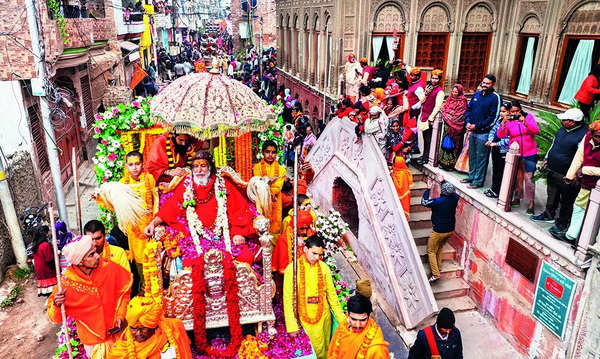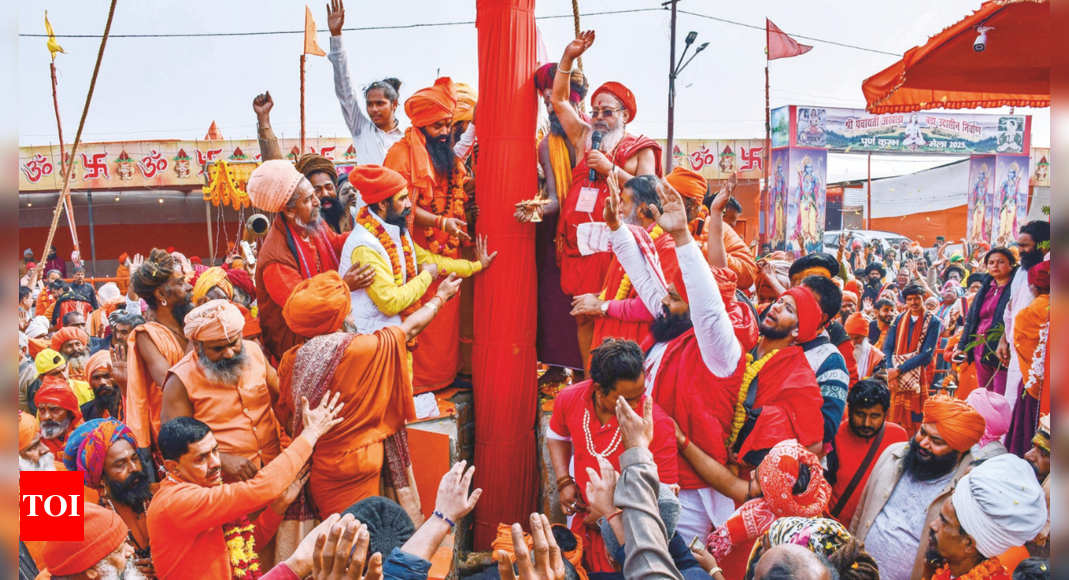1.
Shri Panch Dashnaam Juna Akhada
BASE:
Baba Hanuman Ghat, Varanasi, UP
FOUNDED ON:
1146 AD (as Juna) before that, they were known as Bairagis
HEAD:
acharya Mahamandaleshwar Swami Avdheshanand Giri
DEITY:
dattatreya
UNIQUENESS:
It is the largest and extremely diverse. He hugs everyone he seeks, he has dogs as companions.
DESCRIPTION:
He aligns himself with the Dashnami sect. Apart from being the largest ‘akhara’ in number, it is also perhaps the most diverse and is known to have a rich tradition of ‘astra’ (weapons) and ‘shaastra’ (scriptures). It is home to the largest number of Naga Sanyasis, Hatha Yogis and Sanyasins. It also hosted the newly formed Kinnar Akhara. Many popular spiritual leaders who have centers around the world are affiliated with it.
2. Shri Panchayati Akhara Niranjani
BASE:
Daraganj, Prayagraj, UP
FOUNDED ON:
904 AD
HEAD:
Acharya Mahamandaleshwar Kailashanandji Maharaj
DEITY:
Kartikeya Swami
UNIQUENESS:
It is the second largest. It focuses on education in addition to religion and is known for its educated psychics.
DESCRIPTION:
He is known for having educated seers and is committed to the protection of Sanatan Dharma. Established in Mandvi (Gujarat) in 726 AD The members of this sect see each other as brothers and treat their founder as a guru.
3. Shri Panch Atal Akhara
BASE:
Chaak Hanuman, Varanasi, UP
FOUNDED ON:
646 AD
HEAD:
Acharya Mahamandaleshwar Swami Vishwatman and Saraswati
DEITY:
Ganesha
UNIQUENESS:
One of the three oldest. Known for his extreme discipline.
DESCRIPTION:
This ‘akhara’ works to promote ethical and religious virtues among people. They visualize a ‘sanyasi’ as someone who holds ‘mala’ (rosary) in one hand and ‘bhaala’ (spear) in the other. They have also faced several Muslim invaders. They do not believe in caste system or brahminical order and do not appoint Mahamandaleshwars for this.

4. Shri Panchayati Akhara Mahanirvani
BASE:
Daraganj, Prayagraj, UP
FOUNDED ON:
749 AD
HEAD:
Acharya Mahamandaleshwar Swami Vishokananda maharaj
DEITY:
Sage Kapilmuni (believed to be an incarnation of Lord Vishnu)
UNIQUENESS:
He pioneered the concept of Mandaleshwar. Defend an ecological life
DESCRIPTION:
Committed to spreading the principles of Sanatan Dharma, this ‘akhara’ proposed the concept of Mahamandaleshwar or spiritual head. The idea was to form ‘mandali’ (or group) to attract the masses and inform them about the importance and greatness of religion. Their ‘naga sayasis’ also carry out ‘mimansa’ (religious research and interpretation). The head of this ‘mandali’ was called ‘mandalishwar’, who eventually came to be known as ‘mandaleshwar’. The head of several ‘mandaleshwars’ was called ‘mahamandaleshwar’. The akhara was the first to name a woman ‘mahamandaleshwar’.
5. Shri Taponidhi Anand Akhara Panchayat
BASE:
Trimbakeshwar, Nashik, Maharashtra
FOUNDED ON:
1856 AD
HEAD:
Acharya Mahamandaleshwar Swami Balkanand Giri
DEITY:
Surya
UNIQUENESS:
It fosters freedom, promotes discipline and the nationalist cause.
DESCRIPTION:
Unlike other ‘akharas’, this one does not follow a protocol. A ‘sanyasi’ at the lowest level of the ladder can speak his mind freely. It also does not follow certain fixed practices like Nagar Pravesh. He also chooses learned persons committed to Vedic education and promotion of Indian culture from society and academia to be appointed as Mahamandaleshwar.
6. Shri Panchdashnam Aawahan Akhara
BASE:
Dashashwamedh Ghat, Varanasi, UP
FOUNDED ON:
547 AD
HEAD:
Acharya Mahamandaleshwar Arun Giri Maharaj
DEITY:
Surya
UNIQUENESS:
Naga Sanyasis pioneers, first to set up camp in kumbh
DESCRIPTION:
Aawahan Akhara is considered the pioneer of Naga Sanyasis. Mahant Gopal Giri said that once the Sanyasis went into war. At that time, Adi Shankaracharya asked the sanyasis of Atal and Maha Nirvani Akharas to perform a ‘pind-daan’ (a kind of funeral ritual) and uphold the cause of religion. After the ritual, the sanyasis stripped naked (as if rejecting the last layer of consciousness towards the material world). Then they smeared his body with ashes from a funeral pyre, took a spear, went into battle, and won.
7. Shri Panchdashnam Panch Agni Akhara
BASE:
Girinagar, Bhavanath, Junagadh (Gujarat)
FOUNDED ON:
1192 AD
HEAD:
Acharya Mahamandaleshwar Shri Mat Ram Krishnanand
DEITY:
Gayatri Mata
UNIQUENESS:
Akhara without Naga Sanyasis, takes up social causes like free education, forestry and serving cows.
DESCRIPTION:
This ‘akhara’ comprises Naishtika Brahmachari or someone who promises to remain celibate and live with his guru until death. Adi Shankaracharya named four types of dedicated celibates called Ananda, Chaitanya, Swaroopa and Prakashaka in the four monasteries he established. Their duties included the study and contemplation of scriptures such as the Vedas, Puranas and Upanishads, as well as performing rituals such as worship and sacrifices. Over time, the main objective of this tradition became the main objective of Agni Akhada. Its key objectives include promoting religion, protecting and promoting culture, serving schools, cow shelters, and serving wandering saints.
VAISNAVA
8. Shri Digambar Ani Akhara
BASE:
Shamlaji Kakchowk Temple, Sambhar Kantha (Gujarat)
FOUNDED ON:
1784 AD
HEAD:
Vacant position
DEITY:
Lord Hanuman
UNIQUENESS:
Their nagas wear only white.
DESCRIPTION:
The ‘akhara’ is known to have a maximum number of 850 ‘Khalsas’ (equivalent to Mahamandaleshwars). The Naga sadhus of this akhara wear only white but remain prepared to fight for the religion through both ‘shastra’ and ‘shaastra’. They believe in service and conduct ‘langars’ and ‘bhandaras’ during Kumbh and Magh Melas.
9.
Shri Panch Nirvani Ani Akhara Hanuman Garhi
BASE:
Ayodhya, U.P.
HEAD:
Sri Mahant Murli Das
DEITY:
Lord Hanuman
UNIQUENESS:
Promotes wrestling, fighting without weapons. He had contributed to the development of the constitution.
DESCRIPTION:
The seers of this ‘akhara’ are noted for their unique ’tilak’. But in addition to serving its deity and its devotees, this ‘akhara’ fosters a culture of wrestling and trains professionals. Many of these psychics have participated in national level wrestling competitions and won medals. Shri Mahant Gyan Das Maharaj, who became the president of Akhara Parishad in 2004, was also a champion in Uttar Pradesh and held several titles. The ‘akhara’ also has the tradition of Ni-Yudha or unarmed fighting
10. Akhil Bhartiya Shri Panch Nirmohi Ani Akhara
BASE:
Dheer Sameer Mandir Bansivat, Vrindavan, Mathura, UP
FOUNDED ON:
1720 AD
HEAD:
Sri Mahant Rajendra Das Maharaj
DEITY:
Lord Ram
UNIQUENESS:
Association with the Ram Temple movement
DESCRIPTION:
A key player in the Ram Temple movement and legal battle, the Nirmohi Akhara follows the Ramanandi sect of Vaisnava Sampradaya. The ‘akhara’ was founded by Acharya Ramanandacharya. People, including women, from all castes can be part of this ‘akhara’ and attain important positions. Women can rise to become ‘Mahamandaleshwars’ but do not participate in administrative work. More than six lakh seers are associated with this sect across India.
UDASIN
11. Shri Panchayati Bada Udasin Akhara
FOUNDED ON:
1825 AD
BASE:
Krishnanagar, Prayagraj, UP
HEAD:
Shri Mukhiya Mahant Durgadas (and three other Mukhiyas who head the four directions)
DEITY:
Guru Chandradev
UNIQUENESS:
He does not believe in caste segregation; He contributed to the freedom movement.
DESCRIPTION:
This ‘akhara’ follows the basic principles of devotion, knowledge and renunciation and remains committed to the study of the Vedas, Vedangas and Ashtanga Yoga. They run more than 100 ‘ashrams’ across India. One of the ‘ashrams’ of this sect, based in Sultanpur, actively participated in the Indian freedom movement. It is claimed that in the Kumbh held in the 1920s and 1930s, they also trained revolutionaries.
12. Shri Panchayati Naya Udasin Akhara
BASE:
Kankhal, Haridwar, Uttarakhand
FOUNDED ON:
1846 AD
HEAD:
Mahant Jagtar Muni
DEITY:
Guru Chandracharya
UNIQUENESS:
Committed to serving humanity
DESCRIPTION:
Committed to promoting Sanatan Dharma by serving the society, they remain committed to establishing Sanskrit schools, hospitals, temples and inns for public welfare. Apart from the main pilgrimage sites, during the Ardh Kumbh or Purna Kumbh festivals, the ‘akhara’ offers free food and accommodation to pilgrims and at the same time promotes religious teachings. In times of natural disasters and national crises, the ‘akhara’ actively contributes to maintaining the unity and integrity of the country. During the Covid-19 pandemic, the ‘akhara’ distributed free food and medicine to more than five lakh people
13. Shri Nirmal Panchyati Akhara
BASE:
Kankhal, Haridwar, Uttarakhand
FOUNDED ON:
1856 AD
HEAD:
Shri Gyan Dev
UNIQUENESS:
Close links with Sikhism
DESCRIPTION:
The Akhara was founded by Durga Singh Maharaj in 1856 in Punjab. The ‘akhara’ has close links with Sikhism, especially the Khalsa Sikhs. It is also the home of the Nihang Sikhs. It is said that Guru Gobind Singh sent a group of five saffron-robed seers (Panch Nirmal Gaurik) to Varanasi to learn the Vedas. vedang and Dharma Shastra. However, after learning about it, it is believed that these seers formed their own sect by the name of Nirmal Sampraday.
(Source: UP Tourism Brochure on Akharas; article by Rajiv Agarwal of dnaofhinduism.com)





